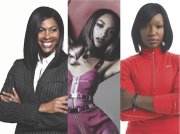By ALESHA CADET
Tribune Features Reporter
acadet@tribunemedia.net
THE CHANGING media environment has created a proliferation of sexually suggestive representations of Bahamian women, according to College of the Bahamas researcher Dr Juliette Storr.
Now, more so than in past years, Dr Storr said people are seeing an increase in negative images of women.
“We have access to more media than at any other period in our history. Sex has been used to sell products, services and new ideas for a very long time. I think the new unregulated market is taking advantage of this and is pushing the ‘sex sells’ agenda to the extreme. We have moved from a very controlled media environment to a very loose, unregulated media environment,” said Dr Storr.
The mass media has used a large amount of space and time telling people that sex sells, and the main spokesperson of the sales pitch is eight times out of ten a woman or a girl.
Dr Storr discussed her research at a recently held round-table discussion, hosted by the Tribune Women’s Section in conjunction with the Bahamas Artists Movement (BAM), the National Art Gallery of the Bahamas (NAGB) and the Bahamas Association of Journalists, of which she is the president.
In her study of the Bahamian media, she said women are primarily represented through five archetypes: Bahamian women as sports hero, Bahamian women as educated professional, Bahamian women as tourist commodity/product, Bahamian women as sex object/sexually promiscuous, Bahamian women as pious/deeply religious.
Speaking about the sexual objectification, Dr Storr said: “In the Bahamas, a country that is highly sexually active, some have even labelled it addictive, we don’t like to openly discuss the impact of these images or representations on our relationships and our identities. Black women are too often portrayed in Bahamian media, especially for concert promotions and entertainment, as over-sexed, one-dimensional boy-toys whose only purpose in life is to juice or grind. This identity is reinforced through images or representations of the jungalist or ‘cutta’ culture.”
Dr Storr said some businesses have gone so far as to use the notion of cuttas in their marketing strategies. She emphasised how the practice has become normalised in society.
The practice has even gone global. An online urban dictionary includes the Bahamian term cutta and jungalist in its index. A cutta is described a woman who is used for casual sex. “Cuttas may be obtained by setting a trap, using a thigh snack from the popular Bahamian restaurant, Bamboo Shack & a $5 phone card,” states the dictionary reference. A jungalist is described as a “loud, abrasive woman”.
“Some people think this is an innovative, humorous way to get people’s attention and sell a product. One must ask, what is the relationship of these images of the Bahamian woman to the actual problems in our society such as violence, sexual abuse of children, rape and sexual harassment, and pornography,” said Dr Storr.
“The jungalist and cutta representations of Bahamian women parallel the African America hip hop culture’s representations of black women as bitches and hoes,” she said.
In her research, Dr Storr conducted an analysis of images displayed in public places, such as Arawak Cay, at Family Island regattas, concerts and political rallies.
In promotional images Bahamian women seem “always ready for sex,” said Dr Storr.
“She is always scantly clothed with most of the emphasis on her hips, crotch and breast. She has no other purpose in life but to be seen and used as a sex object. Many established businesses also display these images in their establishments with no concern for the negative messages they send,” said Dr Storr.
Dr Storr said it is not just an issue of women subjecting themselves to this portrayal as “sex objects,” but also issues of who has the power to create identities, control beliefs, values and ideas about who we are and what is worthy, valuable or important.
“Women in the Bahamas must not only ask themselves what role do I play in accepting these negative portrayals of female sexuality, but also what can I do to make a change. I do not blame media entirely for the amount of crime in this country, for the amount of violence perpetrated against women and girls, as there are many other factors involved. However, it is time for us to examine media’s role in the development of these cultural ideas about the Bahamian woman and our apparent acceptance of it,” said Dr Storr.





Comments
Use the comment form below to begin a discussion about this content.
Sign in to comment
Or login with:
OpenID